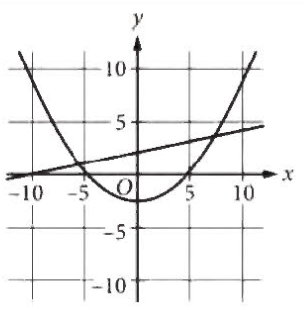SAT MAth Practice questions – all topics
- Advanced Math Weightage: 35% Questions: 13-15
- Equivalent expressions
- Nonlinear equations in one variable and systems of equations in two variables
- Nonlinear functions
SAT MAth and English – full syllabus practice tests
[Calc] Questions Easy
What is the y-coordinate of the y-intercept of the graph of \(y=3^{x}+9\) ?
▶️Answer/Explanation
Ans: 10
To find the \(y\)-coordinate of the \(y\)-intercept of the graph of \(y = 3^x + 9\), we set \(x = 0\) and solve for \(y\):
\[y = 3^0 + 9 = 1 + 9 = 10\]
So, the \(y\)-coordinate of the \(y\)-intercept is \(10\).
Question

The graph of a linear equation and the graph of a quadratic equation are shown. What is true about the point (−1,4)?
- The point satisfies only the quadratic equation
- The point satisfies only the linear equation.
- The point satisfies both equations.
- The point satisfies neither equation.
Answer/Explanation
Ans: C
Question
\(y=(x+3)(x-7)\)
\(y=x-7\)
If \((x,y)\) is a solution to the given system of equations, which of the following could be the value of \(x\)?
- -7
- -3
- 3
- 7
Answer/Explanation
Ans: D
Question

A system of equations consists of a quadratic equation and a linear equation. The equations in this system are graphed in the \(xy\)-plane above. How many solutions does the system have?
- 0
- 1
- 2
- 3
Answer/Explanation
Ans: C
Question
In the \(xy\)-plane, a parabola has vertex (3, 1) and intersects the \(x\)-axis at two points. If the equation of the parabola is written in the form \(y = ‐ax^2 +bx + c\), where \(a, b\), and \(c\) are constants, which of the following could be a value of \(c\)?
- -8
- 2
- 3
- 7
Answer/Explanation
Ans: A
Question
In the \(xy\)-plane, what is the \(y\)-coordinate of the point of intersection of the graphs of \(y = (x ‐ 1)^2\) and \(y = 2x ‐ 3\)?
Answer/Explanation
Ans: 1
Question
\(x-y=1\)
\(x+ y=x^2 -3\)
Which ordered pair is a solution to the system of equations above?
- \((1+\sqrt{3},3)\)
- \((\sqrt{3},-\sqrt{3})\)
- \((1+\sqrt{5},\sqrt{5})\)
- \((\sqrt{5},-1+\sqrt{5})\)
Answer/Explanation
Ans: A
Question
\((x+2)^2+(y-3)^2=40\)
\(y=-2x+4\)
Which of the following could be the \(x\)-coordinate of a solution to the system of equations above?
- \(\sqrt{7}\)
- \(\frac{\sqrt{35}}{2}\)
- \(\frac{6+2\sqrt{34}}{5}\)
- \(\frac{4+\sqrt{191}}{5}\)
Answer/Explanation
Ans: A
Question
\(E = 18,000 – 2,000t\)
\(V = 18,000(0.85^{t})\)
The given equations are two different models that can be used to find the value, in dollars, of a particular car \(t\) years after it was purchased. Which of the following statements correctly compares the values of \(E\) and \(V\) for \(O < t < 9\) ?
- \(E\) is always less than \(V\).
- \(E\) is always greater than \(V\).
- \(E\) is initially greater than \(V\) but eventually becomes less than \(V\).
- \(E\) is initially less than \(V\) but eventually becomes greater than \(V\).
▶️Answer/Explanation
C
Question
Kao measured the temperature of a cup of hot chocolate placed in a room with a constant temperature of70 degrees Fahrenheit ( $\left.{ }^{\circ} \mathrm{F}\right)$. The temperature of the hot chocolate was $185^{\circ} \mathrm{F}$ at 6:00 p.m. when it started cooling. The temperature of the hot chocolate was 156 $6^{\circ} \mathrm{F}$ at 6:05 p.m. and $135^{\circ} \mathrm{F}$ at 6:10 p.m. The temperature of the hot chocolate continued to decrease. Of the following functions, which best models the temperature $T(m)$, in degrees Fahrenheit, of Kao’s hot chocolate $m$ minutes after it started cooling?
A. $T(m)=185(1.25)^m$
B. $T(m)=185(0.85)^m$
C. $T(m)=(185-70)(0.75)^{\frac{m}{5}}$
D. $T(m)=70+115(0.75)^{\frac{m}{5}}$
▶️Answer/Explanation
Ans: D